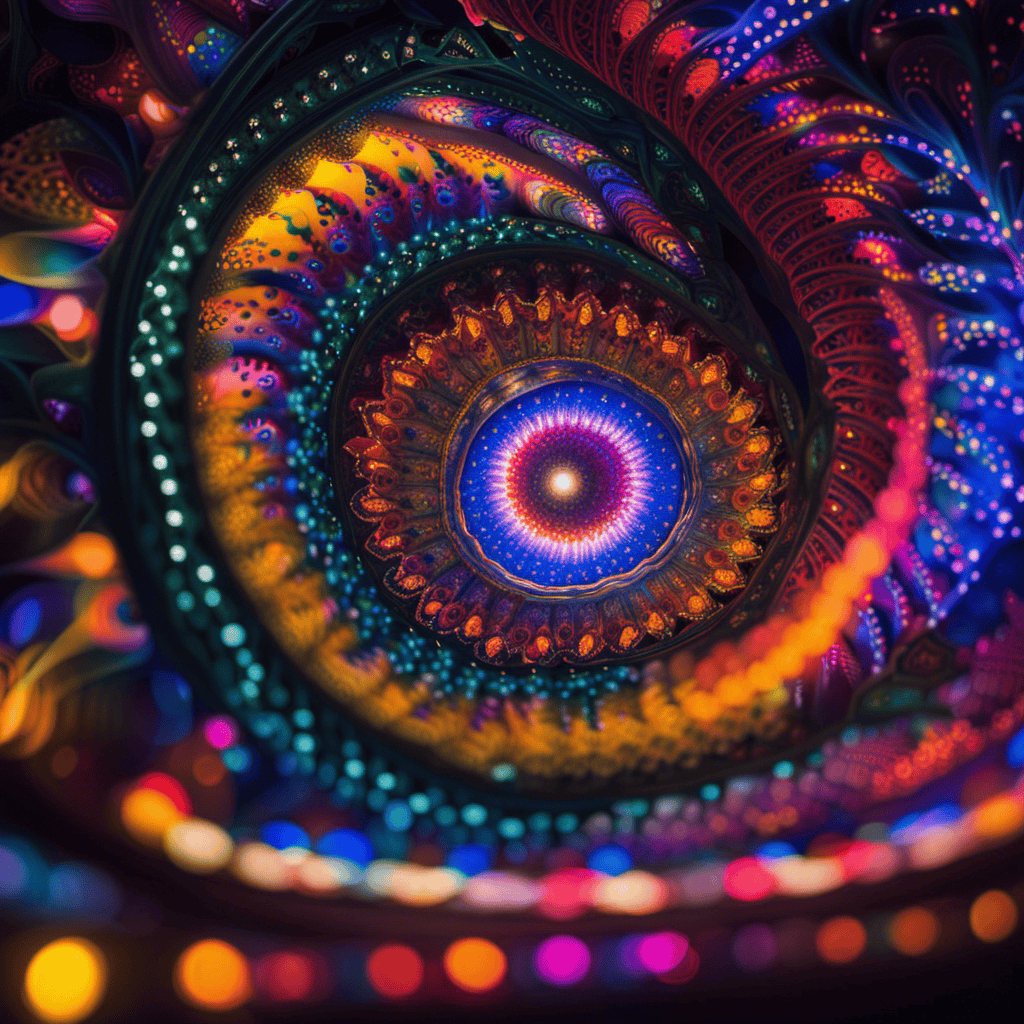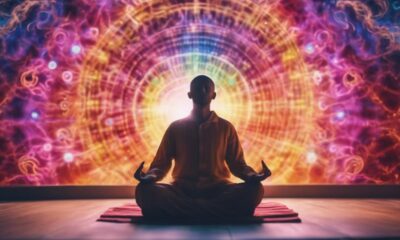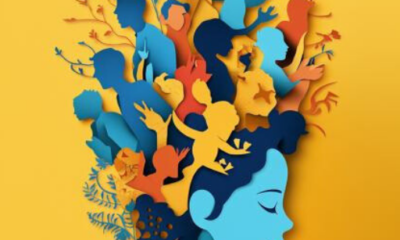Dreams
Having Vivid Dreams When First Falling Asleep

Have you ever had the eerie experience of having intense dreams right when you drift off to sleep? It’s a phenomenon that many of us have experienced at some point in our lives.
As someone who is fascinated by the mysteries of the mind, I couldn’t help but delve into the science behind this intriguing occurrence. What I discovered is that our dreams during the initial stages of sleep can be incredibly vivid due to a combination of factors.
One of the key players in this phenomenon is REM sleep, a stage of sleep characterized by increased brain activity and intense dreaming. During this time, our brains are processing emotions and memories, which can contribute to the vividness of our dreams.
Additionally, stress and anxiety can play a role in the intensity of our dream experiences.
In this article, we will explore the science behind having vivid dreams when first falling asleep, delve into the world of lucid dreaming, and discuss techniques to enhance dream recall.
So, let’s embark on this fascinating journey into the realm of our sleeping minds.
Key Takeaways
- Vivid dreams when first falling asleep are a common phenomenon.
- Factors such as REM sleep, emotions, and memories contribute to the vividness of dreams.
- Stress and anxiety can affect the intensity of dream experiences.
- Understanding the science behind vivid dreams can help enhance dream experiences.
Understanding the Sleep Cycle
When I first drift off to sleep, my brain enters a fascinating journey through different sleep stages, each with their own unique characteristics and dreams. This journey is part of what’s known as the sleep cycle.
The sleep cycle is made up of several stages that repeat throughout the night, and understanding these stages can help explain why we have vivid dreams when first falling asleep.
The sleep stages can be grouped into two main categories: non-REM (rapid eye movement) sleep and REM sleep. Non-REM sleep is further divided into three stages: N1, N2, and N3.
N1 is the stage between wakefulness and sleep, when our brain activity starts to slow down. N2 is a deeper stage of sleep, characterized by a decrease in body temperature and heart rate. N3 is the deepest stage of sleep, also known as slow-wave sleep, when our brain waves slow down even further.
During REM sleep, our brain activity becomes more active, similar to when we’re awake. This is the stage where we experience vivid dreams. REM sleep is also associated with rapid eye movements and muscle paralysis, which prevents us from acting out our dreams.
Understanding the sleep architecture and the role of REM sleep in the sleep cycle provides insight into why we have vivid dreams when first falling asleep. The transition into the subsequent section about the role of REM sleep will further explore this fascinating phenomenon.
The Role of REM Sleep
REM sleep, or rapid eye movement sleep, plays a crucial role in our sleep cycle. It is during this stage that we experience vivid dreams.
Research has shown a strong correlation between the intensity of REM sleep and the vividness of our dreams. This suggests that REM sleep serves a purpose in facilitating the creation of rich and immersive dream experiences.
Discussing the purpose of REM sleep
As soon as I drift off to sleep, my mind takes me on a wild rollercoaster ride of dreams, serving as a captivating canvas for my subconscious to paint vivid images. One of the main purposes of REM sleep, or rapid eye movement sleep, is its importance in memory consolidation.
During this stage of sleep, the brain processes and strengthens memories, enhancing our ability to recall information and experiences. Research has shown that disrupting REM sleep can lead to memory deficits and difficulties in learning new tasks.
Additionally, REM sleep has also been linked to creativity. It’s during this stage that our brains make connections between seemingly unrelated ideas, allowing for novel and innovative thinking. This connection between REM sleep and creativity provides further evidence for the crucial role of REM sleep in our cognitive processes.
Transitioning to the next section, linking REM sleep to dream vividness, we can explore how these factors contribute to the incredibly vivid and immersive dreams we experience.
Linking REM sleep to dream vividness
Immersed in a world of vibrant sensations and fantastical narratives, our minds unleash their wildest creativity during the depths of REM sleep. This stage, characterized by rapid eye movements and increased brain activity, is closely linked to the vividness of our dreams. Research has shown that the more time spent in REM sleep, the more detailed and memorable our dreams become.
To explore this connection, some individuals have turned to dream journaling, recording their dreams immediately upon waking. This practice not only provides insight into the personal meaning behind dreams, but also helps to strengthen the recall of dream content.
On the other hand, sleep deprivation has been shown to decrease REM sleep and subsequently diminish dream vividness. As we delve into the next section on increased brain activity, we will see how this phenomenon contributes to the rich experiences we have during REM sleep.
Increased Brain Activity
Upon drifting into slumber, one’s mind becomes a swirling tempest of heightened neural activity, unleashing a torrent of vivid dreams. This phenomenon can be attributed to the increased brain activity during REM sleep, the stage of sleep when dreams are most likely to occur.
Dream neuroscience has shown that during REM sleep, the brain exhibits a level of activity similar to that of wakefulness, with increased firing of neurons and heightened communication between different brain regions.
Research using functional magnetic resonance imaging (fMRI) has provided valuable insights into the increased brain activity during REM sleep. Studies have shown that regions of the brain associated with visual processing, such as the occipital lobe, are highly active during dreaming. Additionally, there is increased activity in the amygdala, a structure involved in emotional processing, which may explain the intense emotions experienced during vivid dreams.
Furthermore, studies have demonstrated that the prefrontal cortex, responsible for executive functions such as decision-making and self-awareness, exhibits reduced activity during REM sleep. This reduction in prefrontal cortex activity may explain the often bizarre and illogical nature of dreams.
The increased brain activity during REM sleep plays a crucial role in the generation of vivid dreams. The heightened neural activity in visual processing regions, the amygdala, and the decreased activity in the prefrontal cortex contribute to the intense emotions and surreal experiences that characterize these dreams.
Transitioning into the subsequent section about emotional processing, it is important to delve deeper into the role of emotions in shaping dream content.
Emotional Processing
As we explored in the previous subtopic, increased brain activity plays a crucial role in the occurrence of vivid dreams when first falling asleep. However, another important aspect of this phenomenon is emotional processing. When we dream, our brains engage in a complex process of analyzing and interpreting emotions, allowing us to gain insights into our own feelings and experiences.
Dreams often contain symbolic representations of our emotions, serving as a means for our minds to process and make sense of our daily experiences. These symbols can be highly personal and subjective, reflecting our unique perspectives and desires. For example, a dream about flying may symbolize a sense of freedom or empowerment, while a dream about falling may represent feelings of insecurity or loss of control.
In order to better understand the emotional processing that occurs in our dreams, I have created the following table:
| Emotion | Symbol |
|---|---|
| Happiness | Sunshine |
| Fear | Dark shadow |
| Love | Heart |
| Anger | Fire |
Analyzing dream symbolism can provide valuable insights into our emotional state and help us gain a deeper understanding of ourselves. By unraveling the meaning behind these symbols, we can uncover hidden emotions and unresolved issues that may be impacting our waking lives.
Transitioning into the subsequent section, it is important to note that stress and anxiety can significantly influence both the content and intensity of our dreams.
Stress and Anxiety
Engulfed by stress and anxiety, our dreams can be profoundly influenced, altering both their content and intensity. Stress and anxiety have a direct impact on the quality of our sleep, and this includes the dreams we experience during the initial stages of falling asleep.
When we are stressed or anxious, our minds are preoccupied with negative thoughts and worries, which can infiltrate our dreams and make them more intense and emotionally charged. In order to manage stress and anxiety and promote more peaceful and relaxing dreams, there are various stress management and relaxation techniques that can be helpful.
These techniques include deep breathing exercises, progressive muscle relaxation, meditation, and guided imagery. Engaging in these practices before bedtime can help calm the mind and reduce stress levels, leading to more pleasant and soothing dreams.
Additionally, incorporating regular exercise into our daily routine can also contribute to better sleep and more positive dream experiences. Exercise has been shown to reduce stress and anxiety, promote relaxation, and improve overall sleep quality. By engaging in physical activity, we release built-up tension and energy, allowing our minds to unwind and our dreams to become more tranquil.
Transitioning into the subsequent section about sleep disorders and medications, it is important to note that while stress management and relaxation techniques can be effective in improving dream quality, there are instances where individuals may require additional support, such as sleep aids or therapy, to address underlying sleep issues.
Sleep Disorders and Medications
Transition: Now let’s delve into the fascinating world of sleep disorders and the medications used to treat them.
Current Subtopic: Sleep Disorders and Medications
When it comes to having vivid dreams when first falling asleep, it’s important to consider the possibility of an underlying sleep disorder. Sleep disorders can disrupt the normal sleep cycle and lead to unusual dream patterns. Conditions such as insomnia, sleep apnea, and restless leg syndrome have been associated with vivid dreaming and can significantly impact the quality of sleep.
To address these sleep disorders, medications are often prescribed. There are various types of sleep medications available, including benzodiazepines, non-benzodiazepine hypnotics, and melatonin agonists. These medications work by targeting different aspects of the sleep cycle to promote better sleep quality and reduce the occurrence of vivid dreams.
To better understand the relationship between sleep disorders and medications, let’s take a closer look at the following table:
| Sleep Disorder | Common Medications |
|---|---|
| Insomnia | Benzodiazepines, |
| Non-benzodiazepine hypnotics | |
| Sleep Apnea | Continuous positive airway |
| pressure (CPAP) therapy | |
| Restless Leg Syndrome | Dopamine agonists |
As we move forward, we will explore the phenomenon of lucid dreaming and its potential connection to having vivid dreams when first falling asleep.
Lucid Dreaming
Lucid dreaming allows individuals to actively participate in and control their dream experiences. It is a state of consciousness where the dreamer becomes aware that they’re dreaming and can manipulate the dream content.
There are various techniques that can be employed to induce lucid dreaming, such as reality testing, where individuals regularly question whether they’re dreaming or awake. Another technique is keeping a dream journal, where dreamers write down their dreams in detail, enhancing dream recall and increasing the likelihood of becoming lucid.
The benefits of lucid dreaming are numerous. Firstly, it provides an opportunity for self-exploration and personal growth. By actively participating in and shaping the dream, individuals can confront fears, practice skills, and explore their creativity. Secondly, lucid dreaming can be utilized for problem-solving. The dream state provides a unique platform for brainstorming ideas and gaining insights that may not be accessible during waking life. Additionally, lucid dreaming has been associated with improved sleep quality and overall well-being.
Transitioning into the subsequent section about dream interpretation, understanding the meaning behind our dreams can provide valuable insights into our subconscious mind.
Dream Interpretation
When it comes to exploring the significance of vivid dreams, I’ve always been fascinated by the hidden meanings behind them.
Dream symbols and their meanings can offer valuable insights into our subconscious minds.
To help interpret these symbols, I’ve found that keeping a dream journal and reflecting on common themes can provide a deeper understanding of our dreams and ourselves.
Exploring the significance of vivid dreams
As soon as I drift off to sleep, I’m amazed by the incredible significance and impact of those vivid dreams. Research suggests that the quality of our sleep plays a crucial role in the intensity and clarity of our dreams.
When we achieve deep and restful sleep, our brain’s activity during the REM (rapid eye movement) phase is heightened, leading to more vivid and memorable dreams.
Keeping a dream journal can further enhance our understanding of these dreams. By recording our dreams upon waking, we can capture the details and emotions that might otherwise fade away. This practice allows us to analyze recurring themes, symbols, and patterns, providing valuable insights into our subconscious.
By exploring the significance of these vivid dreams, we can gain a deeper understanding of ourselves and our inner thoughts and emotions.
Transitioning into the next section, let’s now explore some tips for interpreting dream symbols and meanings.
Offering tips for interpreting dream symbols and meanings
As we explored the significance of vivid dreams, it becomes clear that understanding the symbolism within these dreams can provide valuable insights into our subconscious mind. Analyzing recurring dreams, in particular, can offer a deeper understanding of our emotions, fears, and desires. To aid in the interpretation of dream symbols and meanings, it can be helpful to create a table that organizes common symbols and their possible interpretations. Here is an example:
| Symbol | Possible Interpretation |
|---|---|
| Water | Emotions, subconscious |
| Flying | Freedom, liberation |
| Teeth falling out | Insecurity, loss of control |
By referring to such a table, we can start to unravel the hidden meanings behind our dreams. This process of decoding symbolism not only enhances our self-awareness but also facilitates personal growth and development. Transitioning to the next section about enhancing dream recall, let’s explore techniques for remembering our dreams in greater detail.
Enhancing Dream Recall
Improving dream recall can lead to a more immersive and unforgettable dream experience. There are several techniques that can help enhance dream recall and increase the chances of remembering the details of your dreams.
One effective method is dream journaling. Keeping a dream journal by your bedside allows you to jot down any dreams you remember as soon as you wake up. This practice helps train your brain to pay more attention to your dreams and improves your ability to recall them.
Another technique is reality checks. Throughout the day, perform simple reality checks like looking at the time or trying to read something twice. This habit can carry over into your dreams, making it easier to recognize when you’re dreaming.
Additionally, incorporating a consistent sleep schedule and creating a calming bedtime routine can also improve dream recall. Ensuring you get enough quality sleep and giving your mind time to relax before bed can make your dreams more vivid and easier to remember.
By implementing these techniques, you can enhance your dream recall and fully embrace the experience of having vivid dreams when you’re falling asleep.
Embracing the Experience
Fully immerse yourself in the experience of dreaming by embracing the vivid imagery and emotions that transport you to another world. When it comes to having vivid dreams when first falling asleep, you can enhance the experience by increasing lucidity and using lucid dream induction techniques.
Lucidity refers to the awareness that one is dreaming while in the dream state. By increasing lucidity, dreamers can take control of their dreams, making them even more vivid and memorable.
There are various techniques that can be used to induce lucid dreams. One such technique is reality testing, where individuals regularly question their reality throughout the day. By asking yourself, ‘Am I dreaming?’ and performing reality checks, such as trying to push your finger through your palm or reading a sentence twice, you can train your mind to question reality in your dreams, leading to increased lucidity.
Another technique is keeping a dream journal. By recording your dreams immediately upon waking, you can enhance your dream recall and become more aware of the patterns and themes in your dreams. This increased awareness can then carry over into your dream state, making it easier to recognize when you are dreaming and increase lucidity.
Overall, embracing the experience of dreaming involves actively engaging with your dreams and taking steps to increase lucidity. By utilizing lucid dream induction techniques, you can fully immerse yourself in the vivid imagery and emotions that come with falling asleep and entering another world.
Frequently Asked Questions
Can vivid dreams when first falling asleep be a sign of a sleep disorder?
Vivid dreams when first falling asleep can indeed be a sign of a sleep disorder. Studies have shown that there’s a relationship between sleep disorders and the intensity of dream vividness during the initial stages of sleep. This suggests that there may be psychological implications associated with this phenomenon. Further research is needed to fully understand the underlying mechanisms and potential implications, but it’s clear that vivid dreams during the early stages of sleep can be indicative of a sleep disorder.
What are some common medications that can affect dream vividness when falling asleep?
There are several medications that can impact dream intensity when falling asleep. Antidepressants, such as selective serotonin reuptake inhibitors (SSRIs) and tricyclic antidepressants (TCAs), have been known to affect dream vividness.
Additionally, medications used to treat Parkinson’s disease, such as levodopa, can also alter dream intensity.
Other drugs like beta blockers, used for hypertension, and certain antihistamines have been reported to influence dream vividness as well.
It’s important to consult with a healthcare professional if you’re experiencing changes in dream intensity while taking any medications.
Can stress and anxiety contribute to having vivid dreams when first falling asleep?
Yes, stress and anxiety can impact the frequency and vividness of dreams in the initial stages of sleep. Research suggests that high levels of stress and anxiety can lead to disrupted sleep patterns, including difficulty falling asleep and increased awakenings throughout the night.
This can result in more opportunities for dreaming and potentially more vivid dreams. Additionally, stress and anxiety can also affect the content of dreams, often causing them to be more intense and emotionally charged.
The relationship between sleep quality and the frequency of vivid dreams when first falling asleep is complex and can be influenced by various factors such as medication, lifestyle choices, and overall mental well-being.
Is it possible to have lucid dreams when experiencing vivid dreams during the initial stages of sleep?
Yes, it’s possible to have lucid dreams even when experiencing vivid dreams during the initial stages of sleep.
Lucid dreaming techniques can be used to increase the likelihood of becoming aware and in control of the dream. By practicing reality checks and setting intentions before sleep, individuals can enhance their ability to recognize when they’re dreaming.
Additionally, interpreting dream symbolism can provide valuable insights into the subconscious mind, aiding in the development of lucid dreaming skills.
Are there any specific techniques or strategies to enhance dream recall for those who frequently have vivid dreams when first falling asleep?
To enhance dream recall for individuals who frequently have vivid dreams, there are several techniques and strategies that can be employed.
Keeping a dream journal is one effective method, as it allows for the immediate recording of dreams upon waking.
Additionally, practicing mindfulness and setting intentions before sleep can help improve dream recall.
Engaging in regular meditation and maintaining a consistent sleep schedule can also contribute to better dream recall.
These techniques have been supported by research and can be effective in enhancing dream recall for those experiencing frequent vivid dreams.
Conclusion
In conclusion, the phenomenon of having vivid dreams when first falling asleep is a fascinating aspect of the sleep cycle. Through increased brain activity during REM sleep, our minds engage in emotional processing and potentially even lucid dreaming.
This can be influenced by factors such as stress and anxiety, which may manifest in our dreams. By enhancing dream recall and embracing these experiences, we can gain valuable insights into our subconscious minds.
So, next time you drift off to sleep, prepare to embark on a detailed and evidence-based exploration of your dreamscape.
Meet Kiran, the guiding light of wisdom behind the empowering content at OurMindAndBody.com. As a talented and compassionate writer, Kiran weaves words with grace and insight, sharing profound knowledge and practical advice to inspire positive transformations in the lives of readers.
With a background in psychology and a deep-rooted passion for well-being, Kiran brings a unique blend of expertise and empathy to her writing. Her journey into the realm of mindfulness, meditation, and yoga began as a personal quest for self-discovery and healing. Having experienced the profound benefits of these practices firsthand, Kiran is committed to empowering others to embark on their own journeys of self-exploration and growth.
Dreams
Choking On Dreams: Unveiling Hidden Desires And Facing Subconscious Issues

In the world of dreams, our minds create a intricate web of symbols and metaphors, providing insight into our subconscious. One such mysterious vision is the feeling of suffocating on dreams, which serves as a potent symbol revealing unspoken desires and addressing lingering problems within us.
Like a tightly knotted knot in the throat, this symbolic manifestation represents a multitude of emotions and experiences that yearn to be acknowledged and understood. It serves as a reflection of our self-respect, feelings of inadequacy, and the need for control and assistance in the tangled web of relationships and situations we navigate.
Moreover, it signifies the challenges we face in our personal and professional lives – the need for protection, restraint, and closure. By delving into the depths of these dreams, we embark on a journey of self-discovery, unraveling the threads of our subconscious and unlocking the door to personal growth and emotional well-being.
Key Takeaways
- Food stuck in the throat in a dream represents self-respect, feelings of inadequacy or unqualification, and the need for help and control in a situation or relationship.
- Dreaming of food stuck in the throat signifies emotional and physical recovery, underlying desires, and the need to let fate take its course.
- The dream of something stuck in the throat expresses criticism, fury, loss, pain, negativity, and subconscious negative feelings of poverty, lack, and inadequacy.
- The dream suggests future hopes and fears, the need to unveil hidden aspects of oneself, lack of trust, and the need to face subconscious issues.
Throat Symbolism
The symbolism of the throat in dreams relates to self-expression, the need for truthfulness, and the exploration of subconscious issues, as indicated by the representation of the throat chakra and the various objects or sensations that may be stuck in the throat.
The throat chakra is associated with communication and self-expression, suggesting that dreams involving the throat highlight the importance of expressing oneself honestly and authentically. This symbolism emphasizes the significance of telling the truth in relationships, as the throat represents the ability to communicate openly and honestly with others.
Dreams of something stuck in the throat may indicate a subconscious desire to speak the truth or a struggle with expressing oneself truthfully in certain relationships. It suggests that exploring and addressing these hidden desires and subconscious issues is essential for personal growth and development.
Emotional Recovery and Closure
Emotional recovery and closure can be achieved through the process of acknowledging and addressing unresolved feelings and experiences. Overcoming past traumas is a crucial step in this process, as it allows individuals to confront and heal from deep-seated emotional wounds.
By acknowledging and processing these traumas, individuals can begin to release the negative emotions associated with them, leading to a sense of inner peace and emotional well-being.
Finding inner peace is another important aspect of emotional recovery and closure. This involves cultivating a sense of acceptance and forgiveness, both for oneself and others involved in the past experiences. Letting go of resentment and anger allows individuals to move forward and create a healthier emotional state.
Additionally, practicing self-care and engaging in activities that promote relaxation and self-reflection can contribute to finding inner peace.
Emotional recovery and closure involve the process of overcoming past traumas and finding inner peace. By addressing unresolved feelings and experiences, individuals can release negative emotions and cultivate a sense of acceptance, forgiveness, and inner tranquility.
Manifestation of Unconscious Feelings
Manifestation of unconscious feelings can provide valuable insights into one’s innermost thoughts and emotions, offering a glimpse into the depths of the human psyche. In the context of dreaming, the manifestation of choking on dreams highlights the importance of self-expression and the healing process.
Dreams in which something is stuck in the throat symbolize the need to overcome self-doubt and insecurities. This manifestation indicates that there may be hidden desires and subconscious issues that need to be addressed. By confronting these feelings and expressing oneself, individuals can embark on a journey of emotional recovery and closure.
The throat, as the seat of self-expression, plays a crucial role in this process. By examining and understanding the underlying emotions behind the dream, individuals can gain valuable insights into their own psyche and take steps towards personal growth and healing.
Conclusion
In conclusion, the metaphorical representation of ‘choking on dreams’ serves as a powerful tool for unveiling hidden desires and facing subconscious issues. Through the symbolism of the throat, this dream signifies the importance of self-respect, self-expression, and the need for help and control in various aspects of life.
By exploring these dreams and delving into the emotional recovery and closure they provide, individuals can gain insight into their unconscious feelings and ultimately embark on a journey of personal growth and self-discovery.
The manifestation of these hidden desires and subconscious issues not only allows for introspection but also emphasizes the significance of effective communication, truth-telling, and examining the root causes of one’s experiences.
This analytical and theoretical approach to understanding dreams offers a profound perspective on the complexities of the human psyche and the power of self-reflection.
Meet Kiran, the guiding light of wisdom behind the empowering content at OurMindAndBody.com. As a talented and compassionate writer, Kiran weaves words with grace and insight, sharing profound knowledge and practical advice to inspire positive transformations in the lives of readers.
With a background in psychology and a deep-rooted passion for well-being, Kiran brings a unique blend of expertise and empathy to her writing. Her journey into the realm of mindfulness, meditation, and yoga began as a personal quest for self-discovery and healing. Having experienced the profound benefits of these practices firsthand, Kiran is committed to empowering others to embark on their own journeys of self-exploration and growth.
Dreams
Communication From Beyond: When Our Beloved Pets Visit In Dreams

In the world of dreams, a mystical bond can be created between the living and the departed. It is often said that “When we shut our eyes, our souls are exposed to the endless possibilities of the universe.” This belief rings true for individuals who have encountered the powerful occurrence of visitation dreams involving their deceased pets.
These ethereal encounters, often occurring in the form of a deceased cat, provide solace and a sense of connection with our beloved companions who have crossed over. While these dreams may seem surreal, they hold significant meaning and symbolism. Understanding the messages and symbols conveyed in these visitation dreams can offer insight into the spiritual realm and provide comfort to grieving pet owners.
In this article, we explore the circumstances surrounding these visitations, delve into the depths of their meanings, and uncover the profound messages that our departed pets bring to us in our dreams.
Key Takeaways
- Dreaming about a deceased pet is a common sign of communication from the pet.
- Deceased pets may visit their owners in dreams to convey comfort or pass on messages.
- Visitation dreams of deceased pets can bring closure to the dreamer.
- Interpretations of visitation dreams can provide insight into their meaning.
When do they visit?
Visitation dreams of deceased pets can occur at any time, providing comfort, reassurance, and important messages to their owners.
The frequency and timing of these dreams can vary for each individual. Factors that may influence the occurrence of visitation dreams include the strength of the bond between the owner and the pet, the level of grief experienced by the owner, and the openness of the owner’s mind to receiving messages from beyond.
These dreams often occur when the owner is in a relaxed state, such as during sleep or meditation, allowing for a deeper connection to be established.
It is important to note that not everyone may experience visitation dreams, as it depends on the individual’s spiritual beliefs and their ability to connect with the spiritual realm.
Nonetheless, when these dreams do occur, they can bring a sense of solace and healing to the grieving pet owner.
Meaning of visitation dreams
The interpretation of dreams involving departed animals can offer valuable insights into the symbolic meanings and messages they may convey. When it comes to visitation dreams of deceased pets, understanding their significance is crucial for gaining a deeper understanding of the messages being communicated.
These dreams hold a spiritual and emotional significance, acting as a form of communication between the dreamer and their departed pet. The visitation dreams serve as a means for the pet to provide comfort, reassurance, and closure to their owners. They may also offer warnings, advice, and share beneficial ideas.
The interpretation of these dreams depends on the actions and occurrences within the dream, such as seeing and petting the deceased cat, which may symbolize luck and the sharing of beneficial ideas.
Overall, visitation dreams of deceased pets hold great significance and provide a unique opportunity for communication from beyond.
Symbols and messages
Symbols and messages conveyed in dreams involving deceased pets hold significant meaning and provide a unique opportunity for individuals to receive communication from their departed companions. Interpreting visitation dreams and understanding the symbolism within them can offer insight and comfort to those grieving the loss of their beloved pets. Dreams involving deceased pets often contain symbols that reflect the qualities or experiences associated with the animal during its life. These symbols can include specific colors, objects, or actions that hold personal significance for the dreamer.
Additionally, messages from deceased pets can be conveyed through emotions, sensations, or even direct communication within the dream. It is important for individuals to pay attention to these symbols and messages, as they can provide guidance, comfort, and a sense of connection with their departed pets.
Frequently Asked Questions
Can deceased pets visit in dreams even if their owners have never had a visitation dream before?
Unexplained encounters with deceased pets visiting in dreams can occur even if their owners have never had a visitation dream before. These encounters can bring emotional healing and comfort to grieving pet owners.
Dreams of deceased pets often have a profound emotional impact, allowing individuals to process their grief and find closure.
This mysterious phenomenon provides a unique opportunity for individuals to connect with their beloved pets on a spiritual level, offering solace and support during the mourning process.
Do all visitation dreams from deceased pets have a specific meaning or message?
To delve into the meaning behind visitation dreams from deceased pets, one must consider the emotional significance they hold. These dreams offer a glimpse into a realm beyond our waking reality, where our departed companions reach out to us.
Interpreting these dreams requires a deep understanding of the bond between humans and their pets, as well as the intricate language of symbols and signs. By exploring the messages conveyed in these dreams, we can gain insight, comfort, and a sense of connection with our beloved pets, even in their ethereal form.
Can visitation dreams from deceased pets occur years after their passing?
Visitation dreams from deceased pets can occur years after their passing, impacting the dreamer in various ways. These long-term effects can provide comfort, closure, and a sense of continued connection with the pet.
The dreamer may experience a deep emotional response, ranging from subtle feelings of peace to overwhelming grief.
Additionally, visitation dreams can occur even if there is no logical explanation for the pet’s presence, suggesting a spiritual connection beyond the physical realm. These unexplained occurrences serve as a reminder of the enduring bond between the dreamer and their beloved pet.
Are there any common symbols or themes that appear in visitation dreams from deceased pets?
Symbolic interpretations of visitation dreams from deceased pets often involve common symbols and themes. These can include:
- Seeing the pet in their energetic form
- Sensing their presence near their old living areas
- Receiving messages through telepathic communication
These symbols and themes can provide emotional healing through dreams, bringing comfort and closure to the dreamer. Dreams act as a conduit for communication from beyond, allowing owners to connect with their departed pets and receive messages of reassurance, comfort, and guidance.
How can one differentiate between a regular dream and a visitation dream from a deceased pet?
One interesting statistic is that according to a study, 60% of people who have lost a pet report experiencing visitation dreams from their deceased companion.
When differentiating between ordinary dreams and visitation dreams, there are several signs to look for. In visitation dreams, the deceased pet may appear in their energetic form, provide comfort or convey messages, and bring feelings of peace. These dreams often feel vivid and may involve telepathic communication, distinguishing them from regular dreams.
Conclusion
In conclusion, visitation dreams from our deceased pets can provide comfort and closure to those who have lost them.
These dreams can symbolize various meanings, such as offering comfort, warnings, and advice, and are often associated with the past.
The actions and occurrences within the dream can provide insight into its interpretation.
While some may question the validity of visitation dreams, they hold deep emotional and spiritual significance for many individuals.
These dreams bring feelings of peace and reassurance, allowing us to connect with our beloved pets even after they have passed away.
Meet Kiran, the guiding light of wisdom behind the empowering content at OurMindAndBody.com. As a talented and compassionate writer, Kiran weaves words with grace and insight, sharing profound knowledge and practical advice to inspire positive transformations in the lives of readers.
With a background in psychology and a deep-rooted passion for well-being, Kiran brings a unique blend of expertise and empathy to her writing. Her journey into the realm of mindfulness, meditation, and yoga began as a personal quest for self-discovery and healing. Having experienced the profound benefits of these practices firsthand, Kiran is committed to empowering others to embark on their own journeys of self-exploration and growth.
Dreams
Anxiety And Desire: Unveiling The Meaning Behind Dreaming Of Your Boyfriend Marrying Someone Else

Delving into the complex world of our dreams can offer deep understanding of our innermost wishes and fears. Within the many dream scenarios, imagining your partner getting married to someone else often stirs up strong feelings. Explore more to uncover the secrets hidden in your dreams.
This dream, veiled in the realm of anxiety and desire, holds multifaceted meanings that tap into the complexities of our subconscious minds. Drawing from psychological research and dream analysis, this article aims to shed light on the underlying implications of dreaming about your boyfriend marrying another person.
By exploring common interpretations, emotional significance, and reflections on relationships, we will delve into the depths of these dreams to decipher their hidden messages. This examination will not only aid in understanding the psychological landscape of dreams but also provide valuable insights into our own emotions, relationships, and personal growth.
Through an objective and evidence-based exploration, we embark on a journey to uncover the enigmatic meaning behind these dreams of love and betrayal.
Key Takeaways
- Dreams about your boyfriend marrying someone else often signify anxiety and tension related to wedding planning and fear of things going wrong.
- Dreaming of your boyfriend getting married reflects a return to childhood and a stage of personal growth and development.
- Dreaming that the person you love is getting married to someone else may indicate insecurity or envy and a lack of commitment toward you.
- Dreams about a loved one marrying someone else may suggest unresolved lover issues and the need for forgiveness and moving on.
Common Interpretations
One common interpretation of dreaming of your boyfriend marrying someone else is that it may reflect a desire for more romance in the personal connection and a wish for a happy family.
Psychological implications of this dream suggest that it represents anxiety and tension related to wedding planning and fear of things going wrong. It can also symbolize a stage of personal growth and development, reflecting a return to childhood.
The dream may indicate a need for progress and independence in one’s journey. Symbolic representations in this dream include a reflection of unresolved issues in the relationship or concerns about a new relationship. It may also signify worries about past hurts and fear of getting hurt again in the current relationship.
Overall, this dream highlights a longing for a stronger emotional connection and a need for communication and discussion of relationship concerns.
Emotional Significance
The emotional significance of dreaming about your partner marrying another person can provide insight into underlying concerns and feelings within the dreamer.
These dreams may evoke a range of emotions such as anxiety, insecurity, envy, and fear.
Psychologically, they may reflect unresolved issues in the dreamer’s current or past relationship, concerns about trust and commitment, or a desire for more romance and connection.
It is important to interpret and cope with these dreams in a healthy manner. This can involve exploring the root causes of the emotions and fears triggered by the dream, engaging in open and honest communication with one’s partner, seeking professional help if needed, and practicing self-care and self-reflection.
By understanding and addressing the psychological implications of these dreams, individuals can gain insight into their own emotions and work towards building healthy and fulfilling relationships.
Relationship Reflections
Relationship reflections can be gleaned from dreams of a partner marrying another person, shedding light on underlying concerns, emotions, and unresolved issues within the dreamer. These dreams serve as a form of self-reflection, providing insight into the dreamer’s relationship insecurities and fears. Here are four key points to consider:
-
Insecurity: Dreaming of a partner marrying someone else may indicate feelings of insecurity within the relationship. It suggests a fear of not being enough for the partner or a lack of trust in their commitment.
-
Trust and Communication: These dreams highlight the importance of trust and open communication in a relationship. They may indicate a need for the dreamer to address their concerns and insecurities with their partner to strengthen the bond.
-
Past Hurts: Dreams of a partner marrying someone else can also stem from unresolved issues or past hurts. The dreamer may be carrying emotional baggage from previous relationships, leading to trust issues in the current relationship.
-
Self-Reflection: Such dreams prompt the dreamer to reflect on their own needs, desires, and fears. It is an opportunity for self-exploration and understanding, allowing the dreamer to identify areas of personal growth and development within the relationship.
By analyzing these relationship reflections, individuals can gain a deeper understanding of their own emotions and work towards building a stronger and more secure relationship.
Frequently Asked Questions
What does it mean if I dream of my boyfriend marrying someone else, but I am not currently in a relationship?
The psychological interpretation of dreaming about one’s boyfriend marrying someone else, despite not being currently in a relationship, suggests that it may reflect unresolved emotions and subconscious processing of past experiences. Symbolically, this dream could represent a fear of being replaced or a longing for a committed relationship. Dream analysis indicates the need for self-reflection and examination of one’s desires and fears. It is important to note that dreams may not always directly relate to one’s present circumstances and should be interpreted with caution.
Can dreaming of your boyfriend marrying someone else be a sign of infidelity or a lack of trust in the relationship?
Dreaming of your boyfriend marrying someone else does not necessarily indicate infidelity or a lack of trust in the relationship. Instead, it may reflect possible underlying fears and insecurities about commitment. It is important to consider the impact of past experiences on current relationships, as dreams can be influenced by unresolved issues and concerns.
However, it is crucial to approach dream interpretation objectively and not jump to conclusions about the state of the relationship based solely on a dream.
Does dreaming of your boyfriend marrying someone else always indicate a desire for more romance in the relationship?
Dreams of your boyfriend marrying someone else do not always indicate a desire for more romance in the relationship. These dreams can reflect emotional insecurities and fears within the individual. Discussing these dreams with your partner can help build trust and strengthen the relationship by promoting open communication.
By understanding the underlying emotions and concerns behind these dreams, couples can address any insecurities and work towards a more secure and fulfilling relationship.
Are there any specific actions or steps I should take if I frequently dream of my boyfriend marrying someone else?
Relationship reassessment and communication with your partner are key actions to consider if you frequently dream of your boyfriend marrying someone else. It is important to discuss your concerns and fears with your partner openly and honestly, as this can help address any underlying issues and strengthen your relationship.
Engaging in open dialogue can also provide clarity and understanding, allowing both parties to reassess the relationship and make informed decisions moving forward. Additionally, seeking professional guidance, such as couples therapy, can be beneficial in navigating these dreams and their potential impact on the relationship.
Can dreams about a loved one marrying someone else be a reflection of past relationship trauma or unresolved issues?
Dream interpretation and psychological analysis suggest that dreams about a loved one marrying someone else can indeed be a reflection of past relationship trauma or unresolved issues. These dreams may symbolize a fear of repeating past mistakes or a need for closure and forgiveness. They could also indicate unresolved emotions and a desire to heal from previous relationship experiences.
Psychological analysis of such dreams can provide insights into one’s subconscious thoughts and emotions, ultimately aiding in personal growth and self-reflection.
Meet Kiran, the guiding light of wisdom behind the empowering content at OurMindAndBody.com. As a talented and compassionate writer, Kiran weaves words with grace and insight, sharing profound knowledge and practical advice to inspire positive transformations in the lives of readers.
With a background in psychology and a deep-rooted passion for well-being, Kiran brings a unique blend of expertise and empathy to her writing. Her journey into the realm of mindfulness, meditation, and yoga began as a personal quest for self-discovery and healing. Having experienced the profound benefits of these practices firsthand, Kiran is committed to empowering others to embark on their own journeys of self-exploration and growth.
-

 Spirituality3 months ago
Spirituality3 months agoHow to Learn About Spiritual Energy: A Beginner's Guide!
-

 Spirituality3 months ago
Spirituality3 months agoHow to Keep Your Spiritual Energy High: Stay Vibrant!
-

 Spirituality3 months ago
Spirituality3 months agoHow to Increase Your Spiritual Energy: Simple and Effective Ways!
-

 Angel Numbers3 months ago
Angel Numbers3 months agoHow to Manifest When Seeing Angel Numbers
-

 Spirituality3 months ago
Spirituality3 months agoHow to Know if You Have High Spiritual Energy: Signs and Tips!
-

 Angel Numbers3 months ago
Angel Numbers3 months agoHow to Meditate on Angel Numbers
-

 Personal Growth3 months ago
Personal Growth3 months agoBook Review: “The Creative Spark: Unleashing Your Inner Artist”
-

 Angel Numbers3 months ago
Angel Numbers3 months agoHow to Choose the Right Angel Numbers











